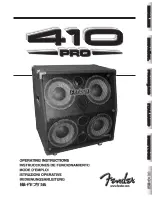
Unlike power amps, ever y speaker cabinet has a pre-determined impedance rating measured in “ohms.” In
most cases this rating is either 4 or 8 ohms (though there may still be some old 2 ohm creakers out there).
The higher the impedance of the speaker cabinet, the more resistance to power it will offer. The lower the
resistance of the speaker cabinet, the less resistance to power it will offer. In other words, HIGHER IMPED-
ANCE MEANS LESS POWER CAN ENTER THE SPEAKER CABINET. LOWER IMPEDANCE MEANS MORE POWER
CAN ENTER THE SPEAKER CABINET.
You may be thinking that you’ve found the solution to the universe—just use speaker cabinets with really
low impedances and you can get skull-crushing power out of your amplifier, right? Wrong. There’s a catch.
Power amps have limits as to how low an impedance they can drive safely. This is what’s known as an
amplifier’s “Minimum Impedance Rating.” If you tr y and operate a power amp below its minimum imped-
ance rating, it will give you lots and lots of power for about five minutes…and then overheat, short out and
fail completely. In other words, THE LOWER THE OPERATING IMPEDANCE OF THE AMPLIFIER, THE HOTTER IT
WILL GET.
750x Power Amplifier Minimum Impedance Ratings
Here’s what this means to the power amp in the 750x. As mentioned previously, the 750x contains a mono
power amp, which makes things fairly simple. The Minimum Impedance Rating of the 750x is 2.6 ohms.
This means that you can safely connect:
• One 8 ohm speaker enclosure
• Two 8 ohm speaker enclosures
• Two 16 ohm speaker enclosures
• One 4 ohm speaker enclosure
The optimum operating impedance for the 750x is 4 ohms. This way you get a good amount of power from
the amp (750 watts—we’d call that “a good amount!”) without operating too closely to the minimum imped-
ance—or, in simple terms, without running the amplifier too hot. That said, the 750x is rated to operate
safely when connecting:
• One 8 ohm and one 4 ohm enclosure (2.6 ohms total)
• Three 8 ohm enclosures (2.6 ohms total)
These two hookups will provide 850 watts of power—which should be more than enough for just about any
application!—but as previously mentioned, your amplifier will run hotter, and an amp that runs at or near its
minimum impedance all the time may wear the life of its components faster than normal. Furthermore,
damage to the power amplifier section of the 750x may occur if speaker enclosures with total impedances
less than the minimum loads listed above are connected to the speaker output section. The owner’s manu-
al that came with your speaker cabinet should state its total impedance. On SWR speaker enclosures, the
total impedance is generally indicated on the speaker’s input panel.
So how do you determine the total impedance of two cabinets hooked up to your 750x? Here’s a quick key
of the most common setups:
One 8 ohm enc one 8 ohm enclosure = 4 ohms total impedance
One 8 ohm enc one 4 ohm enclosure = 2.6 ohms total impedance
One 4 ohm enc one 4 ohm enclosure = 2 ohms total impedance
Here’s another formula: To figure out the total impedance of two or more cabinets of equal value hooked up
in parallel, divide the impedance of one cabinet by the number of cabinets:
Impedance of one cabinet / number of cabinets = total impedance
(For an even more in-depth discussion of impedance and power rating issues, go to the SWR Website at
www.swrsound.com, click on “Press,” then click on “Ar ticles,” then click on “Plug and Play: Setup Tips for
Amps and Speakers”—an ar ticle by SWR founder Steve Rabe that ran in the August ’92 issue of Bass
Player Magazine.)
14 • 750x OWNER’S MANUAL





































